Jongseo Lee
Disentangled Concepts Speak Louder Than Words:Explainable Video Action Recognition
Nov 05, 2025Abstract:Effective explanations of video action recognition models should disentangle how movements unfold over time from the surrounding spatial context. However, existing methods based on saliency produce entangled explanations, making it unclear whether predictions rely on motion or spatial context. Language-based approaches offer structure but often fail to explain motions due to their tacit nature -- intuitively understood but difficult to verbalize. To address these challenges, we propose Disentangled Action aNd Context concept-based Explainable (DANCE) video action recognition, a framework that predicts actions through disentangled concept types: motion dynamics, objects, and scenes. We define motion dynamics concepts as human pose sequences. We employ a large language model to automatically extract object and scene concepts. Built on an ante-hoc concept bottleneck design, DANCE enforces prediction through these concepts. Experiments on four datasets -- KTH, Penn Action, HAA500, and UCF-101 -- demonstrate that DANCE significantly improves explanation clarity with competitive performance. We validate the superior interpretability of DANCE through a user study. Experimental results also show that DANCE is beneficial for model debugging, editing, and failure analysis.
ESSENTIAL: Episodic and Semantic Memory Integration for Video Class-Incremental Learning
Aug 14, 2025Abstract:In this work, we tackle the problem of video classincremental learning (VCIL). Many existing VCIL methods mitigate catastrophic forgetting by rehearsal training with a few temporally dense samples stored in episodic memory, which is memory-inefficient. Alternatively, some methods store temporally sparse samples, sacrificing essential temporal information and thereby resulting in inferior performance. To address this trade-off between memory-efficiency and performance, we propose EpiSodic and SEmaNTIc memory integrAtion for video class-incremental Learning (ESSENTIAL). ESSENTIAL consists of episodic memory for storing temporally sparse features and semantic memory for storing general knowledge represented by learnable prompts. We introduce a novel memory retrieval (MR) module that integrates episodic memory and semantic prompts through cross-attention, enabling the retrieval of temporally dense features from temporally sparse features. We rigorously validate ESSENTIAL on diverse datasets: UCF-101, HMDB51, and Something-Something-V2 from the TCD benchmark and UCF-101, ActivityNet, and Kinetics-400 from the vCLIMB benchmark. Remarkably, with significantly reduced memory, ESSENTIAL achieves favorable performance on the benchmarks.
PCBEAR: Pose Concept Bottleneck for Explainable Action Recognition
Apr 17, 2025Abstract:Human action recognition (HAR) has achieved impressive results with deep learning models, but their decision-making process remains opaque due to their black-box nature. Ensuring interpretability is crucial, especially for real-world applications requiring transparency and accountability. Existing video XAI methods primarily rely on feature attribution or static textual concepts, both of which struggle to capture motion dynamics and temporal dependencies essential for action understanding. To address these challenges, we propose Pose Concept Bottleneck for Explainable Action Recognition (PCBEAR), a novel concept bottleneck framework that introduces human pose sequences as motion-aware, structured concepts for video action recognition. Unlike methods based on pixel-level features or static textual descriptions, PCBEAR leverages human skeleton poses, which focus solely on body movements, providing robust and interpretable explanations of motion dynamics. We define two types of pose-based concepts: static pose concepts for spatial configurations at individual frames, and dynamic pose concepts for motion patterns across multiple frames. To construct these concepts, PCBEAR applies clustering to video pose sequences, allowing for automatic discovery of meaningful concepts without manual annotation. We validate PCBEAR on KTH, Penn-Action, and HAA500, showing that it achieves high classification performance while offering interpretable, motion-driven explanations. Our method provides both strong predictive performance and human-understandable insights into the model's reasoning process, enabling test-time interventions for debugging and improving model behavior.
CA^2ST: Cross-Attention in Audio, Space, and Time for Holistic Video Recognition
Mar 30, 2025
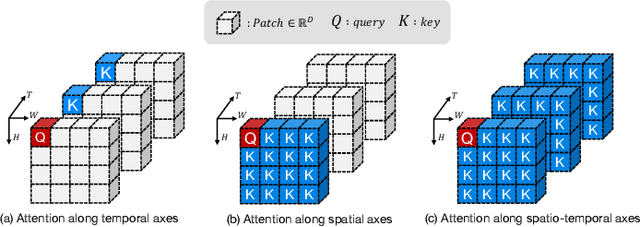

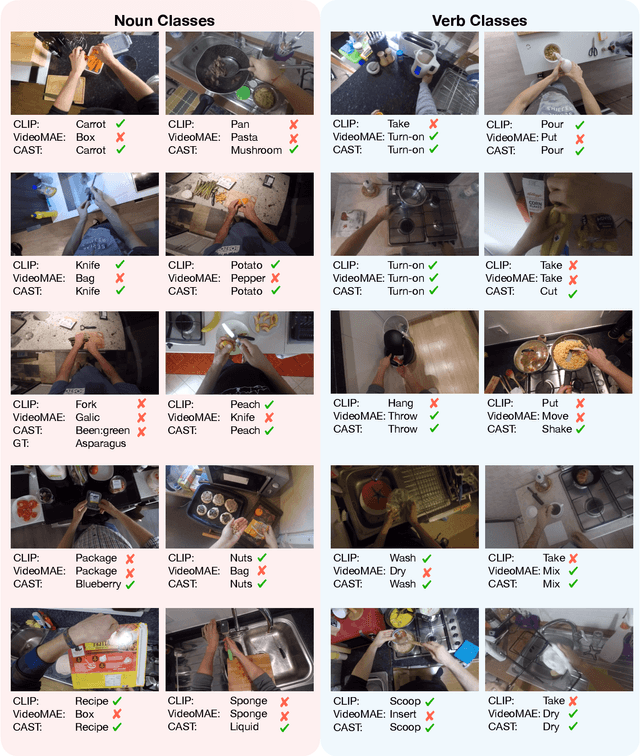
Abstract:We propose Cross-Attention in Audio, Space, and Time (CA^2ST), a transformer-based method for holistic video recognition. Recognizing actions in videos requires both spatial and temporal understanding, yet most existing models lack a balanced spatio-temporal understanding of videos. To address this, we propose a novel two-stream architecture, called Cross-Attention in Space and Time (CAST), using only RGB input. In each layer of CAST, Bottleneck Cross-Attention (B-CA) enables spatial and temporal experts to exchange information and make synergistic predictions. For holistic video understanding, we extend CAST by integrating an audio expert, forming Cross-Attention in Visual and Audio (CAVA). We validate the CAST on benchmarks with different characteristics, EPIC-KITCHENS-100, Something-Something-V2, and Kinetics-400, consistently showing balanced performance. We also validate the CAVA on audio-visual action recognition benchmarks, including UCF-101, VGG-Sound, KineticsSound, and EPIC-SOUNDS. With a favorable performance of CAVA across these datasets, we demonstrate the effective information exchange among multiple experts within the B-CA module. In summary, CA^2ST combines CAST and CAVA by employing spatial, temporal, and audio experts through cross-attention, achieving balanced and holistic video understanding.
PCEvE: Part Contribution Evaluation Based Model Explanation for Human Figure Drawing Assessment and Beyond
Sep 26, 2024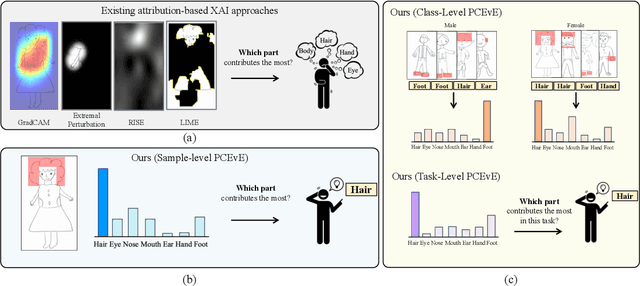

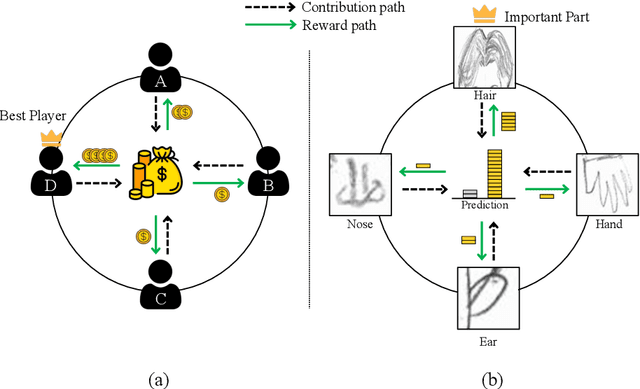
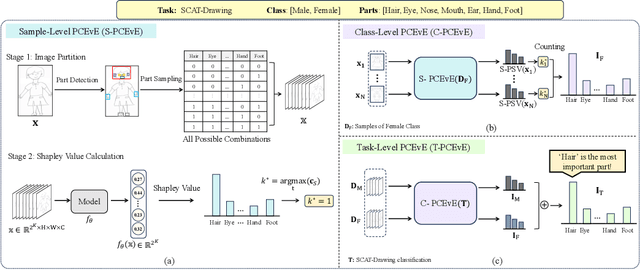
Abstract:For automatic human figure drawing (HFD) assessment tasks, such as diagnosing autism spectrum disorder (ASD) using HFD images, the clarity and explainability of a model decision are crucial. Existing pixel-level attribution-based explainable AI (XAI) approaches demand considerable effort from users to interpret the semantic information of a region in an image, which can be often time-consuming and impractical. To overcome this challenge, we propose a part contribution evaluation based model explanation (PCEvE) framework. On top of the part detection, we measure the Shapley Value of each individual part to evaluate the contribution to a model decision. Unlike existing attribution-based XAI approaches, the PCEvE provides a straightforward explanation of a model decision, i.e., a part contribution histogram. Furthermore, the PCEvE expands the scope of explanations beyond the conventional sample-level to include class-level and task-level insights, offering a richer, more comprehensive understanding of model behavior. We rigorously validate the PCEvE via extensive experiments on multiple HFD assessment datasets. Also, we sanity-check the proposed method with a set of controlled experiments. Additionally, we demonstrate the versatility and applicability of our method to other domains by applying it to a photo-realistic dataset, the Stanford Cars.
CAST: Cross-Attention in Space and Time for Video Action Recognition
Nov 30, 2023
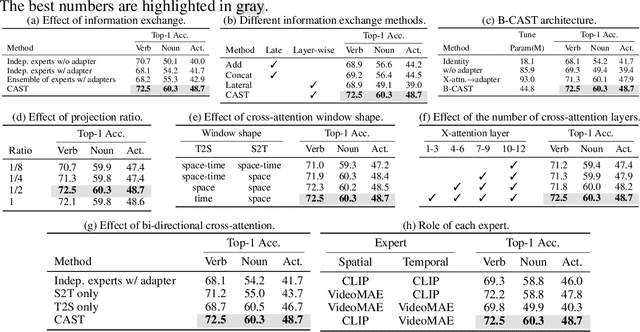
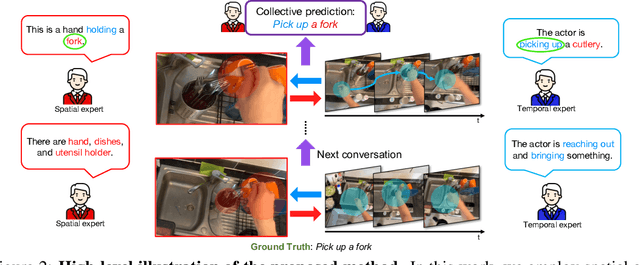
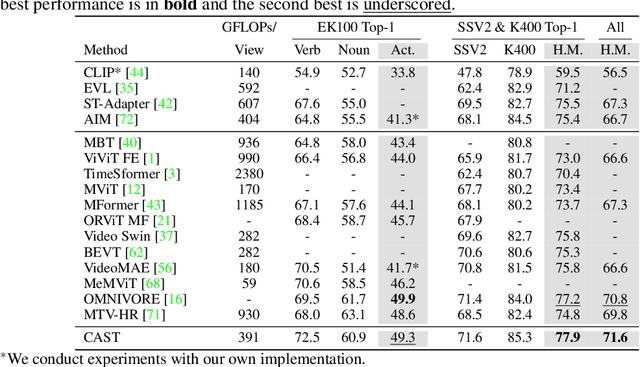
Abstract:Recognizing human actions in videos requires spatial and temporal understanding. Most existing action recognition models lack a balanced spatio-temporal understanding of videos. In this work, we propose a novel two-stream architecture, called Cross-Attention in Space and Time (CAST), that achieves a balanced spatio-temporal understanding of videos using only RGB input. Our proposed bottleneck cross-attention mechanism enables the spatial and temporal expert models to exchange information and make synergistic predictions, leading to improved performance. We validate the proposed method with extensive experiments on public benchmarks with different characteristics: EPIC-KITCHENS-100, Something-Something-V2, and Kinetics-400. Our method consistently shows favorable performance across these datasets, while the performance of existing methods fluctuates depending on the dataset characteristics.
 Add to Chrome
Add to Chrome Add to Firefox
Add to Firefox Add to Edge
Add to Edge